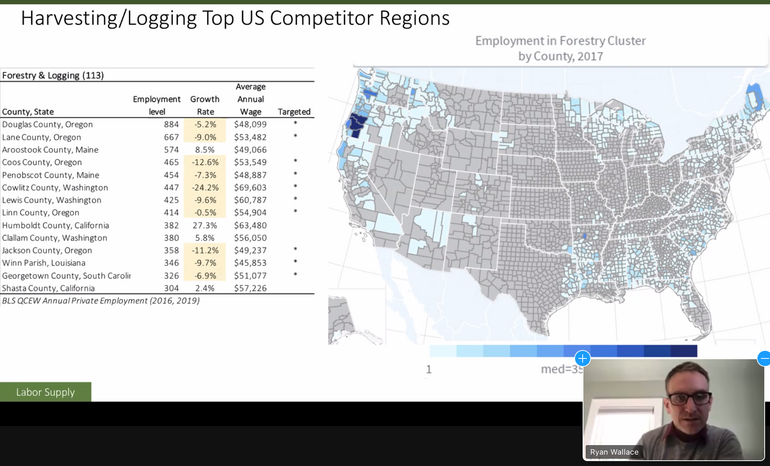Outreach is key to growing Maine's forest industry workforce, study says
 Image / Zoom screen capture
Ryan Wallace of the Center for Business and Economic Research at the Muskie School of Public Service discusses the Maine forest industry's workforce at Friday's FOR/Maine summit.
Image / Zoom screen capture
Ryan Wallace of the Center for Business and Economic Research at the Muskie School of Public Service discusses the Maine forest industry's workforce at Friday's FOR/Maine summit.
Maine's forest industry is going to have to replace as many as 850 jobs in the next few years and find workers for emerging sectors if the industry is going to grow by $4 billion, according to a new study of workforce needs.
And the industry will have to compete with other industries in the state for the expected 27,000 jobs that will have to be filled in the coming years, Ryan Wallace of the Center for Business and Economic Research at the Muskie School of Public Service said at the Forest Opportunity Roadmap Summit on Friday.
Wallace presented the industry's latest workforce development strategy at the virtual conference, which was a halfway-point assessment of the FOR/Maine initiative. The initiative was launched in September 2018, and aims to grow the state's bio-economy from the $8.5 billion industry it is now to a $12 billion a year force in the state by 2025.
Wallace said workforce availability is the biggest obstacle to growth for the industry. It has about 15,000 direct jobs and supports about 18,500 more in the state. More than 26% of the workers will have reached retirement age, but there's not an adequate pipeline to replace them with younger workers, Wallace said.
FOR/Maine was launched by Maine Forest Products Council, University of Maine, Professional Logging Contractors of Maine, Maine Development Foundation, Maine Woodland Owners and Biobased Maine. The initiative seeks to strengthen both the traditional forest products industry, like sawmills and pulp and paper-making, while also boosting emerging technologies including wood fiber insulation, cross-laminated timber and nanocellulose.
While there has been $1 billion in investment in emerging forest technologies in the state in the past two years, Wallace said depending on new technology to boost the industry as a whole isn't a sure thing. While many of them are promising, "There’s an unknown probability of which are going to land," he said. There's also a large differentiation among skill sets and knowledge sets required for new industries.
Since the future of emerging technologies isn't predictable, predicting job growth and needs also is not.
He added that those new technologies that come in from out of state will initially bring skilled workers with them, relying on local labor for unskilled jobs. But skilled jobs will develop as the technologies grow in the state.
The biggest immediate need is in wood harvesting and transportation, jobs that are the foundation for many of the sectors. There's also a longer-term need in the pulp and paper-making industries.
Closing the messaging gap
The industry is dependent on human capital and having people in the workforce. One of the biggest steps the industry can take to recruit workers is make sure the message is being heard, he said.
"In order to attract workers to the industry, it's really about messaging," Wallace said. "There's a big gap in messaging, a big gap in telling the story."
Underlying that is a declining in-state youth pipeline as demographics shift and career opportunities in the industry aren't emphasized. The state has a robust Career and Technology Education program, but the parts of the state where the forest industry has the highest profile, particularly Aroostook and northern Penobscot counties, have the fewest centers.
While the education system has significant capacity, it's fragmented and apprenticeships and intern programs need to be enhanced, he said.
The good news is that few forestry-specific programs exist outside of the state, something Maine could take advantage of in recruiting out-of-staters. "Forest products is not a huge part of economy [in southern New England]," he said. It's a good opportunity to promote jobs and living in the Maine woods.
Other recruitment potential lies in more outreach to veterans, women and other groups not traditionally wooed by the industry, long-term displaced workers from other industries and people who have been incarcerated. Wallace said that the state could also recruit from other areas of the country that have skilled forest industry workers, like the Northwest, Southeast and upper Midwest.
Workforce growth is something that's attainable, he said, but it takes a change in mindset. "It's not rocket science, but that said, it's hard to move the needle."
Wallace made specific suggestions for recruitment, including:
- Raising awareness of opportunities through designing, preparing and executing a coordinated marketing and branding campaign that showcases forest product careers.
- Fostering greater education, outreach and awareness of opportunities to Maine's secondary school students and their advisors.
- Cultivating out-of-state workforce pipelines, including partnering with other Maine heritage industries, like farming and fishing, and integrating it with statewide attraction and recruitment efforts.
- Leveraging the existing workforce infrastructure by increasing coordination and engagement and expanding internship, apprentice and training programs, using retirees as mentors were possible.
- Focusing on on placemaking, and how important workforce attraction is to community-building and developing local economic development
- Maintaining an information system that enables continuous monitoring and evaluation of workforce conditions and requirements across the industry to develop and adapt workforce initiatives.










0 Comments